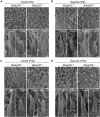BAIAP2L2 Inactivation Does Not Affect Stereocilia Development or Maintenance in Vestibular Hair Cells
- PMID: 35242013
- PMCID: PMC8886116
- DOI: 10.3389/fnmol.2022.829204
BAIAP2L2 Inactivation Does Not Affect Stereocilia Development or Maintenance in Vestibular Hair Cells
Abstract
Hair cells are mechanosensitive cells in the inner ear, characterized by dozens to hundreds of actin-based stereocilia and one tubulin-based kinocilium on the apical surface of each cell. Two types of hair cells, namely cochlear hair cells and vestibular hair cells (VHCs), are responsible for the sensation of sound and balancing information, respectively. In each hair cell, the stereocilia are organized into rows of increasing heights with the mechano-electrical transduction (MET) channels localized at the tips of shorter-row stereocilia. A so-called "row 2 protein complex" also localizes at the tips of shorter-row mechanotransducing stereocilia, which plays important roles in the maintenance of mechanotransducing stereocilia. Recently, we and others identified BAIAP2L2 as a new component of row 2 complex. Baiap2l2 inactivation causes degeneration of the mechanotransducing stereocilia in cochlear hair cells, and leads to profound hearing loss in mice. In the present work, we examined the role of BAIAP2L2 in the VHC stereocilia. Confocal microscopy reveals that BAIAP2L2 immunoreactivity is localized at the tips of shorter-row stereocilia in VHCs. However, stereocilia development and maintenance are unaffected in Baiap2l2-/- VHCs. Meanwhile, MET function of VHCs as well as vestibular functions are also unaffected in Baiap2l2-/- mice. Further investigations show that the stereociliary tip localization of CAPZB2, another known row 2 complex component, is not affected in Baiap2l2-/- VHCs, consistent with the unaltered stereocilia morphology. Taken together, our present data show that BAIAP2L2 inactivation does not affect vestibular hair cell stereocilia.
Keywords: BAIAP2L2; CAPZB2; inner ear; stereocilia; vestibular hair cells.
Copyright © 2022 Yan, Qu, Wang, Zong and Xu.
Conflict of interest statement
The authors declare that the research was conducted in the absence of any commercial or financial relationships that could be construed as a potential conflict of interest.
Figures




Similar articles
-
BAIAP2L2 is required for the maintenance of mechanotransducing stereocilia of cochlear hair cells.J Cell Physiol. 2022 Jan;237(1):774-788. doi: 10.1002/jcp.30545. Epub 2021 Aug 4. J Cell Physiol. 2022. PMID: 34346063
-
Loss of Baiap2l2 destabilizes the transducing stereocilia of cochlear hair cells and leads to deafness.J Physiol. 2021 Feb;599(4):1173-1198. doi: 10.1113/JP280670. Epub 2020 Nov 26. J Physiol. 2021. PMID: 33151556 Free PMC article.
-
BAIAP2L1 and BAIAP2L2 differently regulate hair cell stereocilia morphology.FASEB J. 2024 Aug 15;38(15):e23860. doi: 10.1096/fj.202400121R. FASEB J. 2024. PMID: 39093051
-
Stereocilia morphogenesis and maintenance through regulation of actin stability.Semin Cell Dev Biol. 2017 May;65:88-95. doi: 10.1016/j.semcdb.2016.08.017. Epub 2016 Aug 23. Semin Cell Dev Biol. 2017. PMID: 27565685 Free PMC article. Review.
-
Stereocilia Rootlets: Actin-Based Structures That Are Essential for Structural Stability of the Hair Bundle.Int J Mol Sci. 2020 Jan 3;21(1):324. doi: 10.3390/ijms21010324. Int J Mol Sci. 2020. PMID: 31947734 Free PMC article. Review.
Cited by
-
CIB2 and CIB3 Regulate Stereocilia Maintenance and Mechanoelectrical Transduction in Mouse Vestibular Hair Cells.J Neurosci. 2023 May 3;43(18):3219-3231. doi: 10.1523/JNEUROSCI.1807-22.2023. Epub 2023 Mar 31. J Neurosci. 2023. PMID: 37001993 Free PMC article.
-
The morphological and functional diversity of apical microvilli.J Anat. 2023 Mar;242(3):327-353. doi: 10.1111/joa.13781. Epub 2022 Oct 25. J Anat. 2023. PMID: 36281951 Free PMC article. Review.
References
LinkOut - more resources
Full Text Sources
Miscellaneous

